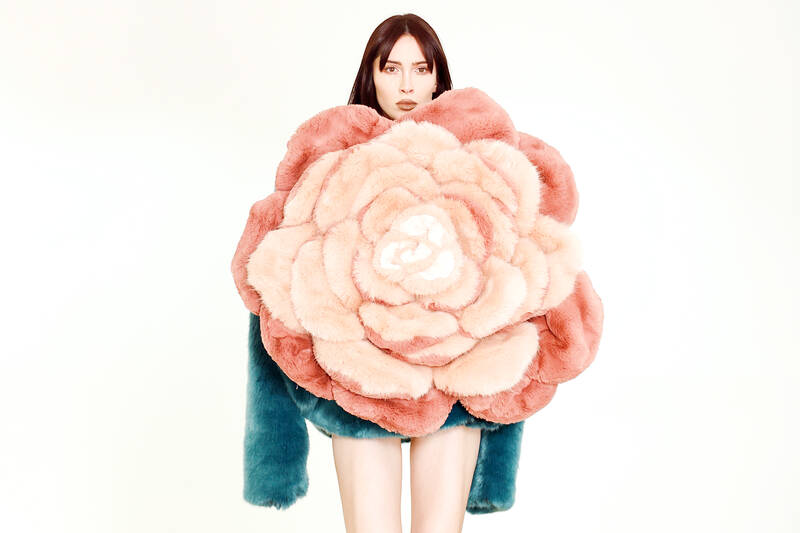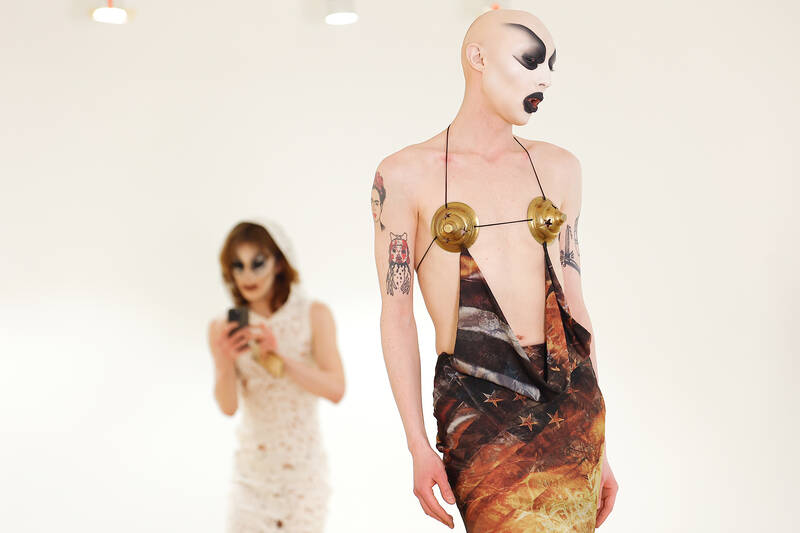Paris Women’s Fashion Week kicked off on Monday with young new labels dominating the catwalks before a trio of hotly awaited designer debuts at Givenchy, Dries Van Noten and Tom Ford in the coming days.
The opening of the world’s biggest fashion week also saw demonstrations from the People for the Ethical Treatment of Animals (PETA) charity and the Brigitte Bardot Foundation to demand the industry stop using animal hides.
Dressed in fake prehistoric fur outfits, five PETA activists held up placards reading “Leave The Stone Age” in front of the French Fashion Institute, while the Brigitte Bardot Foundation sent billboards on trucks denouncing the use of animals for fashion around the City of Light. Fur and sheepskin jackets are back in fashion, with experts like Simon Longland, director of fashion buying at Harrods in London, saying the shearling coat is “set to be the ultimate wardrobe investment” for Fall-Winter 2025.

Photo: EPA-EFE
“We’re here to demand that Paris joins London, Copenhagen and Amsterdam too in banning the use of fur on their catwalks,” PETA spokeswoman Natasha Garnier said.
On the runways, France’s Victor Weinsanto, Japanese label CFCL and New York’s Vaquera held their shows Monday before the bigger corporate luxury jugganauts unveil their Fall-Winter collections later this week. Japanese designer Yusuke Takahashi, who founded CFCL (Clothing For Contemporary Life) just under five years ago, sent out models in knitwear outfits in primary colors, inspired partly by furniture from the 1980s. There was no fur or animal hide in sight, with Takahashi making elaborate use of his favorite material, recycled polyester, which was used for 90 percent of the collection.
“We really focused on knit technology and making new products,” he told reporters afterwards.

Photo: AFP
Victor Weinsanto, an up-and-coming designer from eastern France, stressed that he only used fake leather and fur in his collection in mostly neutral wintery colours of white, beige and black, with a splash of 1980s-style shade of purple.
DEBUTS
Over the next eight days, more than 100 fashion houses will unveil their Fall-Winter 2025-2026 collections, hoping to rally sales in what is an increasingly difficult global luxury market.

Photo: EPA-EFE
Among the most anticipated will be Sarah Burton’s debut at Givenchy on Friday, with the French label given a boost by Hollywood star Timothee Chalamet, who wore a yellow Givenchy suit at the Oscars ceremony at the weekend.
Burton, a 51-year-old Briton who made her name as creative director at Alexander McQueen, was appointed to Givenchy in September.
“Givenchy has a very beautiful history,” she told Vogue in a profile last month. “It appeals to me because it’s a small house, and it’s in Paris.”
Burton is one of a number of recent changes at major brands, with Belgian veteran Dries Van Noten stepping down from his eponymous label last year and handing the reins to fellow countryman Julian Klausner, 33.
Klausner’s first collection on Wednesday will be closely scrutinized. The French Haute Couture and Fashion Federation has also pulled off a coup by luring Tom Ford, a mainstay of New York Fashion Week, to Paris for the first time.
Chief designer Haider Ackermann, in the top job at Tom Ford since September and also tasked with leading a brand defined by its founder, will also be making his catwalk debut on Wednesday.
DOWNTURN
French luxury heavyweights Louis Vuitton, Dior, Saint Laurent and Chanel will produce the biggest budget shows this week, with their front row seats fought over by celebrities and influencers. Dior’s show on Tuesday could be the last from head designer Maria Grazia Chiuri, with persistent rumors and press reports that she is on the way out. Northern Irish stylist Jonathan Anderson, who is currently at the helm of Spanish label Loewe, is tipped as her potential replacement.
The luxury industry as a whole has seen profits fall and sales slow.
Paris-based LVMH, Europe’s largest company by market value, reported a 17 percent fall in annual net profits which it attributed to the end of the luxury-buying “euphoria” following the COVID-19 pandemic.
Analysts see weakness in the key luxury market of China, reduced appetite for high-priced goods, and widespread economic uncertainty as other reasons for the decline.
Fellow French luxury giant Kering reported a 62 percent drop in profits last year, largely due to struggles at its flagship Gucci brand. Elsewhere on Monday, the Financial Times reported that Prada had emerged as the frontrunner to buy fellow Italian label Versace from Capri Holdings for about 1.5 billion euros (US$1.6 billion).
The takeover would combine two of Italy’s best-known luxury fashion brands.

April 14 to April 20 In March 1947, Sising Katadrepan urged the government to drop the “high mountain people” (高山族) designation for Indigenous Taiwanese and refer to them as “Taiwan people” (台灣族). He considered the term derogatory, arguing that it made them sound like animals. The Taiwan Provincial Government agreed to stop using the term, stating that Indigenous Taiwanese suffered all sorts of discrimination and oppression under the Japanese and were forced to live in the mountains as outsiders to society. Now, under the new regime, they would be seen as equals, thus they should be henceforth

Last week, the the National Immigration Agency (NIA) told the legislature that more than 10,000 naturalized Taiwanese citizens from the People’s Republic of China (PRC) risked having their citizenship revoked if they failed to provide proof that they had renounced their Chinese household registration within the next three months. Renunciation is required under the Act Governing Relations Between the People of the Taiwan Area and the Mainland Area (臺灣地區與大陸地區人民關係條例), as amended in 2004, though it was only a legal requirement after 2000. Prior to that, it had been only an administrative requirement since the Nationality Act (國籍法) was established in

With over 80 works on display, this is Louise Bourgeois’ first solo show in Taiwan. Visitors are invited to traverse her world of love and hate, vengeance and acceptance, trauma and reconciliation. Dominating the entrance, the nine-foot-tall Crouching Spider (2003) greets visitors. The creature looms behind the glass facade, symbolic protector and gatekeeper to the intimate journey ahead. Bourgeois, best known for her giant spider sculptures, is one of the most influential artist of the twentieth century. Blending vulnerability and defiance through themes of sexuality, trauma and identity, her work reshaped the landscape of contemporary art with fearless honesty. “People are influenced by

Three big changes have transformed the landscape of Taiwan’s local patronage factions: Increasing Democratic Progressive Party (DPP) involvement, rising new factions and the Chinese Nationalist Party’s (KMT) significantly weakened control. GREEN FACTIONS It is said that “south of the Zhuoshui River (濁水溪), there is no blue-green divide,” meaning that from Yunlin County south there is no difference between KMT and DPP politicians. This is not always true, but there is more than a grain of truth to it. Traditionally, DPP factions are viewed as national entities, with their primary function to secure plum positions in the party and government. This is not unusual